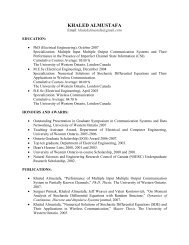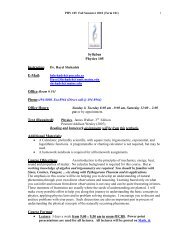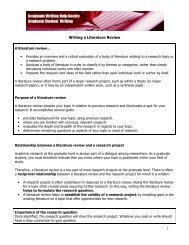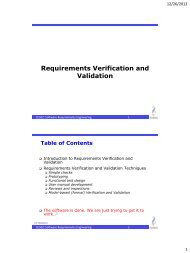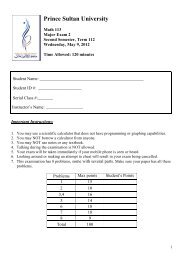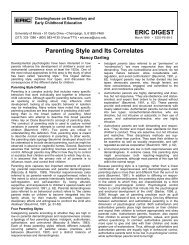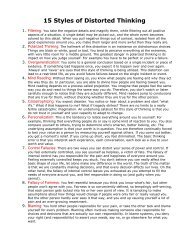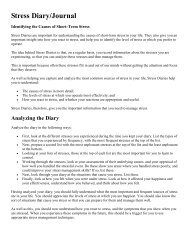Chapter 19: Electric Charges, Forces, and Fields - PSU
Chapter 19: Electric Charges, Forces, and Fields - PSU
Chapter 19: Electric Charges, Forces, and Fields - PSU
Create successful ePaper yourself
Turn your PDF publications into a flip-book with our unique Google optimized e-Paper software.
Ch. <strong>19</strong> Solution PHY 205 Hayel Shehadeh<strong>Chapter</strong> <strong>19</strong>: <strong>Electric</strong> <strong>Charges</strong>, <strong>Forces</strong>, <strong>and</strong> <strong>Fields</strong>Answers Conceptual Questions4. Initially, the bits of paper are uncharged <strong>and</strong> are attracted to the comb bypolarization effects. (See Figure <strong>19</strong>-5 <strong>and</strong> the accompanying discussion.)When one of the bits of paper comes into contact with the comb, it acquirescharge from the comb. Now the piece of paper <strong>and</strong> the comb have charge ofthe same sign, <strong>and</strong> hence there is a repulsive force between them.8. No. If the ball is displaced slightly upward from the equilibrium position, theattractive electrostatic force will be larger than the gravitational force, whichwill displace the ball farther upward. Similarly, if the ball is displaced slightlydownward, the gravitational force is now stronger than the electrostatic force,<strong>and</strong> the ball will move farther downward. Therefore, the equilibrium isunstable.10. The proton can be moving in any direction at all relative to the direction ofthe electric field. On the other h<strong>and</strong>, the direction of the proton’s accelerationmust be in the same direction as the electric field.18. No. The electric flux through a surface depends on the total chargeenclosed by the surface, but is completely independent of the location of theenclosed charges.Solutions to Problems <strong>and</strong> Conceptual Exercises2. An electrically neutral object is given a negative charge.Each electron carries both charge <strong>and</strong> mass, so adding or subtracting electrons will change the object’smass.Solution: 1. (a) Giving the object a negative charge requires the addition of electrons, which havemass. We conclude that the object’s mass will increase as a result of being charged.2. (b) The best explanation is I. To give the object a negative charge we must give it more electrons,<strong>and</strong> this will increase its mass. Statement II is false, <strong>and</strong> statement III fails to distinguish betweencharge <strong>and</strong> mass conservation.Likewise, giving an object a positive charge requires the removal of electrons, decreasing the object’smass.
Ch. <strong>19</strong> Solution PHY 205 Hayel Shehadeh7. A large number of carbon atoms are collected together in a system.Each carbon atom has 6 electrons, <strong>and</strong> each electron carries a charge equal to −e = −1.60×10 −<strong>19</strong> C.We need only multiply the number of electrons by the amount of charge carried by each.Solution: Multiply thenumber of electrons by −e: 6 Q N e nN eA 23 1 <strong>19</strong> 66 2 mol 6.022 10 mol 1.60 10 C 1 10 CThis is a huge amount of charge, but you must keep in mind that carbon atoms are electrically neutral,so that there is an equal amount of positive charge in the nuclei <strong>and</strong> the net charge of the carbon atomsis zero.11. Four pairs of conducting spheres, all with the same radius, areshown in the figure at right, along with their initial charges. Thespheres in each pair are now brought into contact, allowing chargeto transfer between them.Charge will be transferred until the two spheres in each pair havethe same charge. Sum the charge on each pair <strong>and</strong> divide by twoto determine the net charge remaining on each sphere after thetransfer. Compare that value to the initial charge to determine theamount of charge transferred.Solution: For pair A we note that the total charge is – 6q so that −3q will remain on each sphere afterthey are brought into contact. That means that 2q of charge is transferred. By a similar reasoning wefind that 4q is transferred for pair B, 3q is transferred for pair C, <strong>and</strong> charge q is transferred for pair D.The ranking is D < A < C < B.If a pair had charges −5q <strong>and</strong> +5q, the net charge is zero, <strong>and</strong> charge 5q would be transferred if the twospheres were brought into contact.16. An insulating sphere has a uniform surface charge density, <strong>and</strong> exerts a force on a point charge that isplaced nearby but outside the sphere. The insulating sphere is then replaced by an otherwise identicalconducting sphere.Consider the behavior of insulating <strong>and</strong> conducting materials when answering the conceptual question.Solution: 1. (a) The magnitude of the force between the point charge <strong>and</strong> the conducting sphere willbe less than the force between the point charge <strong>and</strong> an insulating sphere. To see this, first note thatboth the sphere <strong>and</strong> the point charge are positive. Therefore, the positive charge on the sphere willmove as far away from the point charge as possible (as opposed to the uniform charge on an insulator,which cannot move). The larger distance between the charges will reduce the repulsive force betweenthe conducting sphere <strong>and</strong> the insulating sphere according to Coulomb’s law.2. (b) The best explanation is III. The charge on a conducting sphere will move as far away aspossible from the point charge. This results in a reduced force. Statement I is false, <strong>and</strong> statement IIignores the effect of the redistribution of charge on the conducting sphere due to the nearby pointcharge.If the sphere were charged positively <strong>and</strong> the point charge were negative, then positive charges wouldcollect on the near side of the conducting sphere <strong>and</strong> the force would be greater than it would be for aninsulating sphere.20. Two charges of unequal magnitude exert an electrostatic force on each other.Use Coulomb’s law (equation <strong>19</strong>-5) to find the magnitude of the force between the two charges.Solution: 1. (a) Applyequation <strong>19</strong>-5 directly: 6 6q1q3.1310 C 4.47 10 C2 9 2 2F k2 2 8.9910 Nm / C 1.93 Nr0.255m
Ch. <strong>19</strong> Solution PHY 205 Hayel Shehadeh2. (b) The magnitude of the electrostatic force depends upon the product of the charges of bothparticles, so the negative charge experiences a force magnitude that is the same as that experienced bythe positive charge.The forces experienced by the two charges must also be the same magnitude <strong>and</strong> opposite in directionin order to be consistent with Newton’s Third Law.24. Five point charges, q1 q, q2 2 q, q3 3 q, q4 4q, <strong>and</strong>q5 5q, are placed in the vicinity of an insulating spherical shellwith a charge +Q distributed uniformly over its surface.Use Coulomb’s law (equation <strong>19</strong>-5) to determine the magnitudes of theforces exerted on each of the charges. Treat the charge on the sphere asif it were a point charge at the center of the sphere. A charge inside ofthe shell would experience no net force.Solution: The magnitude of the force exerted on each of the charges is proportional to the magnitudeof its charge <strong>and</strong> inversely proportional to the square of the distance from the charge to the center of2the sphere. If F k Qq d we can find that0,F 0, F F , F F , F F , <strong>and</strong> F F . The ranking of the magnitudes (ignoring2 3 451 2 9 0 3 4 0 4 9 0 5 4 0the signs) is thus F 1 < F 2 < F 4 < F 3 < F 5 .Calculus can be used to prove F 1 = 0, but it is very difficult. An easier approach is to use Gauss’ law(section <strong>19</strong>-7), which indicates that the electric field (<strong>and</strong> thus the force on q 1 ) is zero everywhereinside the shell.31. Four charges are situated at the corners of a square as shown in thediagram at right.The force on charge q 2 is a vector sum of the forces from the other threecharges. Let q 2 be at the origin <strong>and</strong> q 3 be on the positive x-axis. UseCoulomb’s law (equation <strong>19</strong>-5) to find the vector sum of the threeforces, from which we can find the magnitude <strong>and</strong> direction of the netelectrostatic force on q 2 .Solution: 1. Find F 1:2. Find F 3:22.0 2.0 k q1 q2kq q kqF ˆ ˆ ˆ1 y y y2 2 2d d d22.0 3.0 6.0 k q2 q3k q q kqF ˆ ˆ ˆ3 x x x2 2 2d d d3. Find F 4:2.0 4.02k q2 q4 xˆ yˆ k q q xˆ yˆ 2.0 2kqF4 2 2 2xˆyˆ2d 2 2 2d 2 2 d
Ch. <strong>19</strong> Solution PHY 205 Hayel Shehadeh4. Find the vectorsumof the three forces:5. Find thedirection ofF netfrom the +xaxis:6. Find the magnitudeof F net:2 2 2 2 2.0 2kq 6.0kq 2.0 2kq 2.0kqF ˆˆnet 2 2 2 2d d x d d y net 2 3.0 xˆ 2 122.0kq 2d 9 2 2 6 2.0 8.99 10 N m / C 2.4 10 C 20.33 mF x yˆ 4.2 N ˆ 0.39 Nnet, xyˆF1 net, y 10.39 N tan tan 5.4 180 174.6F 4.1 N 2 2Fnet 4.2 N 0.39 N 4.2 N2 2 3.0 xˆ 2 1yˆF 3is the largest of the three force, three times bigger than F 1<strong>and</strong> over twice as big as F 4. That iswhy F netpoints mainly in the same direction as F 3.35. Three charges are arranged as indicated in the figure <strong>and</strong> exertelectrostatic forces on each other.Use Coulomb’s law (equation <strong>19</strong>-5) to find the electric forces on q1due to the other two charges, then find the vector sum of those twoforces using the component method of vector addition. Let q1be at theorigin <strong>and</strong> q3be on the positive x-axis.Solution: 1. (a) UseCoulomb’slaw to find thecomponents of F 2:2. Find the magnitudesof the components:3. Use Coulomb’s law tofind the components ofF 3:4. Add the componentsto find F net:5. Find the direction ofF net, measuredcounterclockwise fromthe +x-axis:F k q1 q222 sin30 ˆ cos30 ˆd x y 9 2 2 6 6 8.9910 N m / C 2.110 C 6.310 C 1 3 F ˆ ˆ22 x y0.0435 m 2 2 yˆ 31 Nxˆ 54 N9 2 2 6 68.9910 N m / C 2.110 C0.8910 C k q1 q3F ˆˆ3 x x2 2d0.0435 m 8.9 N xˆ F ˆ ˆnet F2 F3 x y 31 8.9 N 54 N 22 Nxˆ 54 Nyˆ F1 net, y154 N tan tan 68 180 248 F net, x 22 N
Ch. <strong>19</strong> Solution PHY 205 Hayel Shehadeh6. Find the magnitude ofF net: 2 22 2netnet, xnet, y 22 N 54 N 58 NF F F7. (b) If the distance d were doubled, the magnitude of the electrostatic force would be decreased by afactor of 4 <strong>and</strong> the direction would be unchanged.If q 3 were instead a positive charge, F 3would point toward the left, the magnitude of the net forcewould be larger (67 N), <strong>and</strong> the angle θ would point closer to the x ˆ direction (233°).48. Three charges are positioned as shown at right.Each of the three charges produces its own electric field that surroundsit. The total electric field at any point is the vector sum of the fieldsfrom each charge. Use equation <strong>19</strong>-10 <strong>and</strong> the component method ofvector addition to find the magnitude electric field at the pointsindicated in the problem statement.Let q1be at the origin <strong>and</strong> q3be on the positive x-axis.rSolution: 1. (a) At a pointhalfway betweencharges q1<strong>and</strong> q2the vectors E 1<strong>and</strong> E 2cancel one another. The remainingcontri-bution comes from q . 3Find thedistance rfrom q3to the midpoint of theopposite side:2. Apply equation <strong>19</strong>-10 to find3 :2 2 2r d 2 dr 23d43 0.0295 m 4r 0.02555 m9 2 2 6kq 8.9910 Nm / C 5.0010 C3EE 3 2 2r0.02555 m2 76.89 10 N/C3. (b) At this location, the electric fields from q2<strong>and</strong> q3add, <strong>and</strong> the resulting field points toward q . 3The field due to q1will have the same magnitude as found in part (a) <strong>and</strong> will be perpendicular to thecombined fields of q2<strong>and</strong> q . 3The vector sum of the electric fields from all three charges will have amagnitude greater than that found in part (a).4. (c) Find the components of1 :5. Find the components of2 :6. Find the components of3 :7. Let q1 q2 q3 q<strong>and</strong> find the vector sum: k q1 k q 1 2 3 2 E ˆ ˆ ˆ ˆ1 x y 2 23d4d x y3 3 E cos30sin30 E k q2 k qE ˆ ˆ 22cos60 x sin 60 y 2 2 2xˆ 2 3 yˆd2E k q3 k qE ˆ ˆ 33cos60 x sin 60 y 2 2 2xˆ 2 3 yˆd 2E E E Enet 1 2 3 kq 2 3 2 E ˆˆnet 4 4 32 d 3 x y 3 dd
Ch. <strong>19</strong> Solution PHY 205 Hayel Shehadeh8. Determine the magnitude ofnet :EE net 2d 3 39 2 6 Enet2 2kq 2 3 2 4 4 38.99 10 N m / C 5.00 10 C2 8.1100.0295 m 84.<strong>19</strong> 10 N/C 4<strong>19</strong> MN/CAs expected, the field is larger at the point midway between q2<strong>and</strong> q3, about six times larger inmagnitude than at the point midway between q1<strong>and</strong> q2.57. Four charges of equal magnitude but alternating signs arearranged at the corners of a square as shown in the diagramat the right.<strong>Electric</strong> field lines diverge away from positive charges<strong>and</strong> converge toward negative charges. The number oflines of force entering or leaving a charge is proportionalto the magnitude of the charge.Solution: The lines of force are sketched at right.An electric field diagram can reveal a wealth ofinformation in a concise fashion when it is drawncorrectly.63. Four Gaussian surfaces are shown at right.Apply Gauss’s law to answer the conceptual questions.Solution: The electric flux through each surface isproportional to the amount of charge enclosed by thatsurface. Surface A encloses charge +2q, surface B enclosescharge +q, surface C encloses zero net charge, <strong>and</strong> surfaceD encloses charge – q. The ranking of these surfaces inorder of increasing electric flux, starting with the mostnegative, is therefore:D < C < B < A.Even though the electric flux through surface C is zero, itdoes not mean that E = 0 everywhere across surface C. Infact, there is a substantial field at every part of surface C,but there are just as many electric field lines entering thesurface as there are leaving the surface.80. A point charge situated at the origin produces an electric field that completely surrounds it.Use the definition of the electric field (equation <strong>19</strong>-10) to find the magnitude of the charge that createsthe stipulated electric field. Because the electric field points toward the origin <strong>and</strong> therefore towardthe charge, the sign of the charge must be negative.
Ch. <strong>19</strong> Solution PHY 205 Hayel ShehadehSolution: Solve equation <strong>19</strong>-10 for q,assuming the charge is negative:36,000 N/C0.75 m 22Erq 9 2 2k 8.9910 N m /Cq 2.3 C62.3 10 CIf the sign of the charge had been positive, the field would have pointed in the94. The configuration of the charged balls <strong>and</strong> the force vectors on theleft ball are depicted in the diagram at right.The magnitude of the electric force, the tension in each thread, <strong>and</strong>the magnitude of the charge on each ball are the same for bothballs. So, we will solve for these quantities with respect to the ballon the left. Apply Newton's Second Law in the horizontal <strong>and</strong>vertical directions to the left ball <strong>and</strong> solve for the magnitude ofthe electric force F, the string tension T, <strong>and</strong> the charge q on eachball.Solution: 1. (a) WriteNewton's SecondLaw in each direction forthe left ball:F T sin 20.0 F 0xF T cos 20.0 mg 0yx ˆ direction.2. Solve the x equation for F:3. (b) Solve the y equation for T:4. (c) Use the result of part (a) tofind q: mg F T sin 20.0 sin 20.0 mg tan 20.0cos 20.0 4 2 41.4 10 kg 9.81 m/s tan 20.0 5.0 10 N 0.50 mN1.4 10 4 kg9.81 m/s2mgT cos 20.0cos 20.02kqF 2d31.5 10 N 1.5 mNFq d k 8.9910 N m / C45.010 N90.0205m4.8 10 C 4.8 nC9 2 2If the mass of each ball were to double, both F <strong>and</strong> T would double as well, but the charge on eachwould only need to increase by2 in order for the thread angle to remain 20.0° with the vertical.





